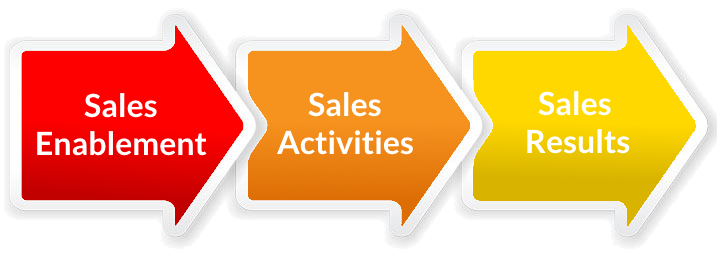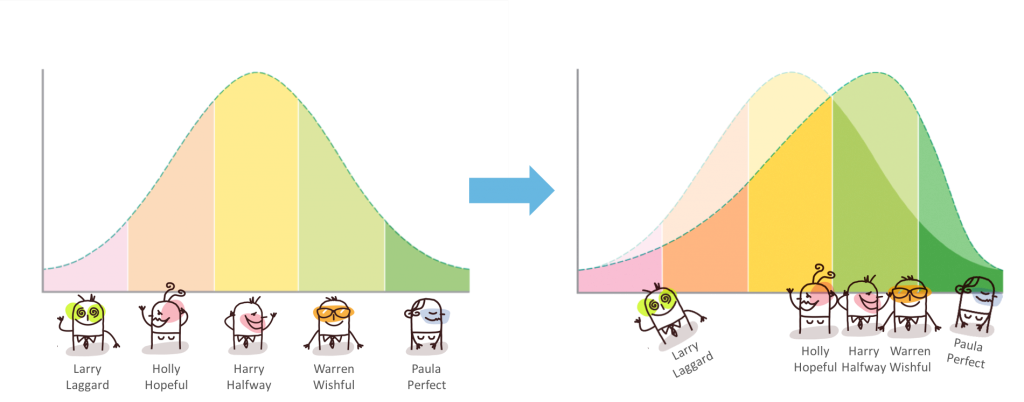You have been investing a ton of money on sales enablement but if you don’t know how to measure its effectiveness, you are probably wasting your money.
In the last couple of years, sales enablement has grown from a buzzword into a strategic investment for organizations and has started to take a decent portion of the budget. And like every other investment, you have to measure its ROI. But how do you that?
For many years, the definition of sales enablement was vague and sales leaders didn’t know which metrics to use to measure its performance. Today, the definition is clear. According to HubSpot “sales enablement is the processes, content, and technology that empower sales teams to sell efficiently at a higher velocity”
In this article, we’re not gonna get into what these processes, technologies, and contents are. If you want to learn more about these concepts, you can always take HubSpot’s free sales enablement course. We will rather focus on how to measure the effectiveness of your sales enablement efforts.
So how can we break this down?
Basically, sales enablement is all about getting better sales results. In other words, it’s about the things that you do to sell more efficiently. Things like implementing certain processes, using technology, and leveraging content.
However, there's an indirect relationship between sales enablement and sales results. Your sales enablement efforts improve the effectiveness of your sales activities, and that has a positive impact on your sales results. Therefore, to measure the effectiveness of your sales enablement program, you have to measure both sides separately.

Sales Activity Metrics
Alright, you have a sales enablement program in place. But how much does your sales team adhere to these processes, use that technology & content? And how much does your program improve your sales activities?
1. Adherence to sales process
To drive healthy deals, your sales reps must follow the sales process. Break your sales process down into the set of sales behaviors you would expect to occur during each sales stage. And don’t let deals advance unless all expected actions have occurred. Although most CRM systems do not track these behaviors, you can implement a manual tracking system. And this will help you to understand where reps are skipping important selling actions.
2. Technology usage
Sales technology is rapidly evolving and you might have equipped your reps with several tools to collect, structure, process, and report information that enables better selling. But what’s the percentage of your sales reps using these tools on a daily basis? You better track this metric carefully.
3. Content effectiveness
This is one of the areas where your marketing and sales teams need to be aligned very well. Compelling content is crucial for your salespeople. Therefore knowing which content is working and which content isn’t is extremely important. You have to measure total views, downloads, and ratings, and compare those metrics to revenue. Your sales technology should allow you to tie content consumption back to closed or lost deals so that marketing knows if their work is making an impact.
4. Time to quota attainment
Often also referred to as ramp-to-revenue, this refers to the time it takes for sales reps to fully ramp and start contributing revenue. Given the high cost-of-hire for sales reps, this is a really important metric to track. And cutting it down should be one of the primary parameters to improve the effectiveness of your onboarding efforts.
5. Number of careless sales behavior
You shouldn’t just track positive sales behaviors. Make sure you also track the careless sales behaviors that derail your deals. Things like deals that have moved back several times, late-stage deals where the deal amount is changed numerous times, or deals created in late-stage forecast categories by mistake. This will also help you uncover coaching opportunities.
6. Actual selling time
Typically a salesperson has 50 hours per week. And according to Forbes, salespeople spend only 35% of their time on core selling. For the rest of their time, they are looking for case studies, building their own presentations, sinking time into expense reports, etc. You can take this figure as a benchmark and improve your metric gradually. By providing sales reps with all the processes, tools and content they need to sell, when they need them, the more time they’ll have to actually sell and close more deals.
7. Sales force turnover rate
According to Harvard Business Review, annual turnover among U.S. salespeople run as high as 27%. Employee turnover is a big problem, and extremely costly. You spend a lot on hiring, recruiting and developing your sales reps. There might be many reasons why you lose your personnel. Therefore pay close attention to this metric.
8. Employee engagement
Increasingly more and more companies are realizing that their employees are not engaged. You can measure this either by measuring employee satisfaction or net promoter score. Because research indicates that there's a positive correlation between employee engagement and quota attainment. The more your sales reps are engaged, the better they will attain their quota.
9. Sales enablement survey score
You can always conduct a survey on your sales team to gather further sentiment about the impact of sales enablement program. Getting both qualitative and quantitative feedback, you can understand which enablement areas are weakest or even missing.
Sales Results Metrics
OK, you have been doing your best to excel at sales enablement, but how do you know whether your efforts are paying off or not? The ultimate goal of sales enablement is to have a positive impact on your sales results.
There are several metrics to measure your sales results, and most probably you have already been measuring them even before you have done anything about sales enablement. That’s great. All you have to do is to measure the improvement on these metrics after you have started working sales enablement.
10. Quota attainment
Probably, the number-one deliverable of sales enablement is to help bring your salespeople to peak performance. And quota attainment is the best measure of sales rep performance. If your sales team have reached their sales target in a given period, they have 100% quota attainment. Your sales enablement program should lift your team’s ability to hit quota. A recent research noted that only 61% of reps in SaaS businesses achieve their quota. On the other hand, according to Aberdeen Group, best-in-class organizations have 99% overall team quota attainment and 62% higher attainment than average companies.
11. Quota distribution
If you want to improve our overall quota attainment, you should be focusing our enablement efforts on the core sales performers and try to move the middle. Because according to the Sales Executive Council “a 5% shift in the performance of the core performers yields over 70% more revenue when compared to a 5% shift in high performers productivity”. Your top performers will always find a way to exceed quota. Therefore, sales enablement efforts should focus on the middle, where you can get the biggest return.
12. Length of sales cycle
Thanks to the involvement of multiple decision makers, the average length of a B2B sales cycle has gone up by over 22% in the past five years. Insight into where deals get stuck is extremely valuable to your enablement efforts. It helps you uncover any friction points in your sales process. It might be your sales rep not executing the sales process effectively or not following the sales playbook. You should look at your sales cycle time both in aggregate and by sales stages to drive better enablement outcomes.
13. Conversion rates in the funnel
Your sales funnel tracks how prospects flow from lead to closed won business. Throughout this sales process, there are several conversions taking place; from MQL to SQL, from SQL to opportunity, and so on. A tiny improvement in conversions through this funnel can have a major impact on the sales result. Your sales enablement improvements might help identify leads better, let your reps respond faster, or help them communicate more targeted messages–these things drive better conversion rates.
14. Win rate
Win rate is the percentage of opportunities proposed/quoted that the organization won. And it helps you measure how well you are equipping your sales team against the competition. A recent study indicates that the average win rate is 47% across several industries. You should drill into this data by different dimensions: customer segment, competitor, sales team, sales rep, region etc. This will help you figure out where you should invest more energy with your sales enablement activities.
15. Average deal size
Average deal size is the average dollar amount per closed deal. One way to increase your deal size is to offer a stronger value proposition to your prospects. Another way is to build better relationships by taking them through your sales process properly. And both are related to your sales enablement activities; how well you train and equip your sales team.
16. Sales velocity
You might already be measuring individual components of this metric (like win rate, average deal size, etc.) But when it comes to measuring success in sales enablement, sales velocity might be the most accurate metric. It is a measure of how fast your leads are becoming customers. Sales enablement has the potential to improve every part of this formula:

17. Sales efficiency
Sales efficiency is the ratio of gross revenue generated by a sales team as compared to the cost of the team including salaries, benefits, incentives, office space, training, software, and other expenses. It is one of those high-level indicators whether your business is worth investing or not. Your sales enablement activities should definitely increase your sales efficiency.
18. Leading KPI attainment
Some sales organizations prefer to define a “high-value sales behavior” and track it as a KPI, along with all the other sales metrics. For instance, instead of just logging every sales call as a sales behavior, they only log those calls with a decision maker that last more than 20 mins. This metric ensures reps are keeping up the right levels and the right kind of sales activity.
19. Sales rep lifetime value
Rep LTV is the total revenue brought in by a sales rep during the time they are employed. For example, if you had an average tenure of 36 months and a quota $1.5 million, theoretically, they could deliver $4.5 million during their tenure if everything works out perfectly. Your sales enablement program should improve this metric and, help you to develop your Sales enablement strategy.


